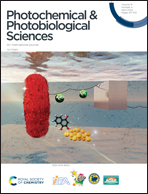Highly sensitive eight-channel light sensing system for biomedical applications†
Abstract
We demonstrate the potential of an eight-channel light sensing platform system, named Black Box I (BBI), for rapid and highly sensitive measurement of low-level light using a nonradioactive optical readout. We developed, normalized, and characterized the photon sensitivities of the eight channels of the BBI using placental alkaline phosphatase (PLAP) as a model imaging reporter. We found that the BBI system had a statistically strong linear correlation with the reference IVIS Lumina II system. When we applied normalization constants, we were able to optimize the photomultiplier tubes (PMT) of all eight channels of the BBI (up to r2 = 0.998). We investigated the biomedical utilities of BBI by: (i) determining alkaline phosphatase activities in mouse plasma samples as a diagnostic secretory biomarker of cancer, and (ii) diagnosing cancer metastases in the organs of mice bearing triple negative breast cancer. We provide an important new addition to low-cost biomedical instruments intended for pre-clinical diagnostic imaging with high sensitivity, high sample throughput, portability, and rapid on-site analysis of low-level light.



 Please wait while we load your content...
Please wait while we load your content...